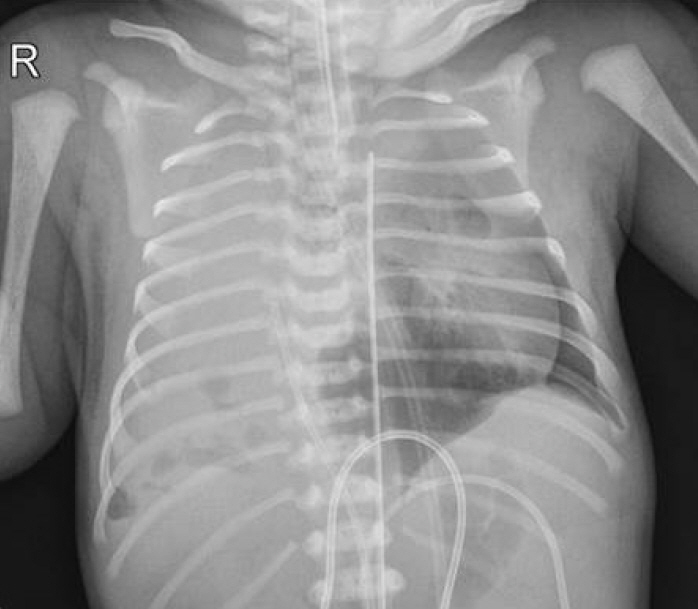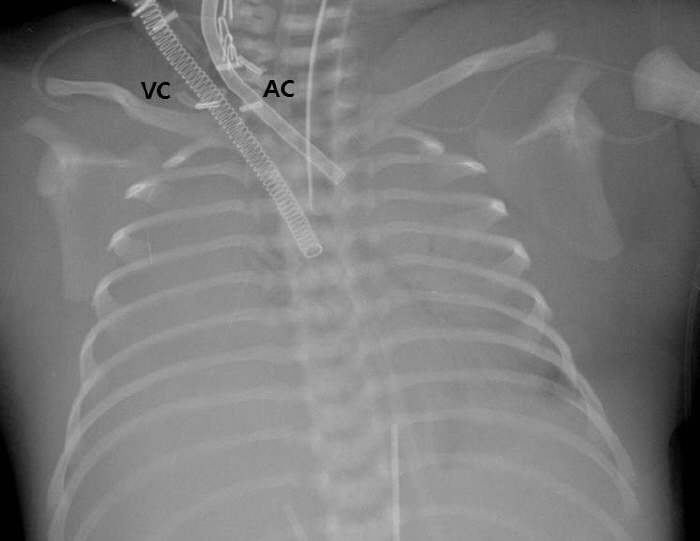Korean J Crit Care Med.
2016 May;31(2):152-155. 10.4266/kjccm.2016.31.2.152.
Extracorporeal Membrane Oxygenation Cannula Malposition in the Azygos Vein in a Neonate with Right-Sided Congenital Diaphragmatic Hernia
- Affiliations
-
- 1Division of Pediatric Critical Care Medicine, Asan Medical Center Children's Hospital, Seoul, Korea. drpsj@amc.seoul.kr
- 2Division of Pediatric Cardiac Surgery, Asan Medical Center, University of Ulsan College of Medicine, Seoul, Korea.
- KMID: 2350924
- DOI: http://doi.org/10.4266/kjccm.2016.31.2.152
Abstract
- Malposition of the extracorporeal membrane oxygenation (ECMO) venous cannula in the azygos vein is not frequently reported. We hereby present such a case, which occurred in a neonate with right-sided congenital diaphragmatic hernia. Despite ECMO application, neither adequate flow nor sufficient oxygenation was achieved. On the cross-table lateral chest radiograph, the cannula tip was identified posterior to the heart silhouette, which implied malposition of the cannula in the azygos vein. After repositioning the cannula, the target flow and oxygenation were successfully achieved. When sufficient venous flow is not achieved, as in our case, clinicians should be alerted so they can identify the cannula tip location on lateral chest radiograph and confirm whether malposition in the azygos vein is the cause of the ineffective ECMO.
MeSH Terms
Figure
Cited by 1 articles
-
The Future of Research on Extracorporeal Membrane Oxygenation (ECMO)
Ji Young Lee
Korean J Crit Care Med. 2016;31(2):73-75. doi: 10.4266/kjccm.2016.31.2.73.
Reference
-
References
1. Hedrick HL, Crombleholme TM, Flake AW, Nance ML, von Allmen D, Howell LJ, et al. Right congenital diaphragmatic hernia: prenatal assessment and outcome. J Pediatr Surg. 2004; 39:319–23.
Article2. Boloker J, Bateman DA, Wung JT, Stolar CJ. Congenital diaphragmatic hernia in 120 infants treated consecutively with permissive hypercapnea/spontaneous respiration/elective repair. J Pediatr Surg. 2002; 37:357–66.
Article3. Fisher JC, Jefferson RA, Kuenzler KA, Stolar CJ, Arkovitz MS. Challenges to cannulation for extracorporeal support in neonates with right-sided congenital diaphragmatic hernia. J Pediatr Surg. 2007; 42:2123–8.
Article4. Byrnes J, Prodhan P, Imamura M, Frazier E. Accidental azygos vein extracorporeal membrane oxygenation cannulation in a neonate with premature closure of the ductus arteriosus. ASAIO J. 2011; 57:344–5.
Article5. Balmaks R, Sufficool KE, White FV, Byrge MM, Kolovos NS. Extracorporeal membrane oxygenation cannula malposition in the azygos vein in an infant. Int J Artif Organs. 2013; 36:518–21.
Article6. Irish MS, O’Toole SJ, Kapur P, Bambini DA, Azizkhan RG, Allen JE, et al. Cervical ECMO cannula placement in infants and children: recommendations for assessment of adequate positioning and function. J Pediatr Surg. 1998; 33:929–31.
Article7. Thomas TH, Price R, Ramaciotti C, Thompson M, Megison S, Lemler MS. Echocardiography, not chest radiography, for evaluation of cannula placement during pediatric extracorporeal membrane oxygenation. Pediatr Crit Care Med. 2009; 10:56–9.
Article
- Full Text Links
- Actions
-
Cited
- CITED
-
- Close
- Share
- Similar articles
-
- Four Cases of Extracorporeal Membrane Oxygenation for Congenital Diaphragmatic Hernia
- Thoracoscopic Repair of a Right-sided Congenital Diaphragmatic Hernia: A case report
- Successful Retrieval of a Fractured Guidewire during Extracorporeal Membrane Oxygenator Insertion
- Azygos and right superior intercostal vein injury secondary to blunt trauma: a case report
- Unilateral Congenital Diaphragmatic Eventration Mimicking Congenital Diaphragmatic Hernia




